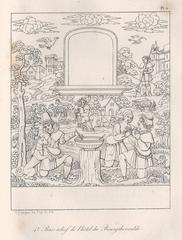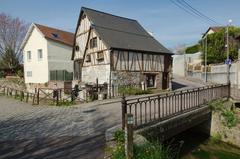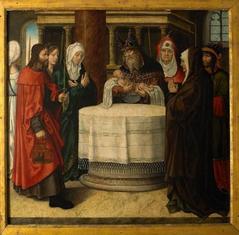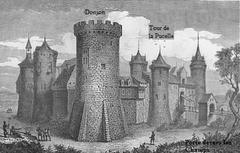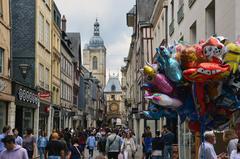Rouen Cathedral Visiting Hours, Tickets & Historical Sites Guide
Date: 03/07/2025
Introduction
Rouen Cathedral, officially known as Cathédrale Notre-Dame de Rouen, is a towering emblem of Normandy’s spiritual and artistic heritage. With origins tracing back to the 4th century, it stands as a testament to the evolution of French Gothic architecture, the resilience of its community through centuries of change, and the enduring allure that has inspired artists such as Claude Monet. This guide explores everything you need to plan your visit, from current opening hours and ticketing to the cathedral’s remarkable history, architectural highlights, and practical travel tips.
For real-time updates on opening hours, events, and visitor access, always consult the official Rouen Cathedral website and trusted travel platforms (Wikipedia; Discover Walks; History Tools; FranceRent).
Table of Contents
- Introduction
- History and Architectural Evolution
- Architectural Features
- Visitor Information
- Special Events and Nearby Attractions
- Frequently Asked Questions (FAQ)
- Visuals and Media Suggestions
- Conclusion and Recommendations
- Sources and Further Reading
History and Architectural Evolution
Foundations and Romanesque Beginnings
Rouen Cathedral’s sacred site has served as a Christian center since the 4th century, with archaeological finds revealing early Paleochristian and Carolingian structures beneath the current edifice (Wikipedia). The first substantial stone church, built in the Romanesque style during the 11th century, was consecrated in 1063 by Archbishop Maurille in the presence of William the Conqueror (Wikipedia). This period laid the foundation for the cathedral’s later Gothic transformation.
Gothic Expansion and Flamboyant Renaissance
The transition to Gothic architecture began in the mid-12th century, inspired by the innovations at Saint-Denis. The Saint-Romain Tower’s construction in 1145 marked the cathedral’s entry into the Gothic era, introducing pointed arches, ribbed vaults, and flying buttresses for a more luminous and elevated interior (Wikipedia).
The west façade, rebuilt multiple times, reached its most ornate form in the 15th century under master builder Roulland Le Roux and Cardinal d’Amboise. The Flamboyant Gothic style is evident in the intricate stonework and sculpted figures, while the Butter Tower (Tour de Beurre), funded by indulgences for butter consumption during Lent (1485–1506), further exemplifies the cathedral’s evolving landscape (Discover Walks).
In the early 16th century, a collapse of the original spire led to its reconstruction, and the Lady Chapel was expanded, reflecting increasing Marian devotion (Wikipedia).
Restoration and Modern Preservation
The cathedral has faced numerous calamities, including lightning strikes, fire, and war damage—most notably the 1822 fire that destroyed the Renaissance spire and World War II bombings that damaged key structures (Discover Walks). The current cast iron spire, completed in 1882, made Rouen Cathedral the tallest building in the world for several years (Wikipedia). Restoration efforts continue to this day, with recent incidents such as the 2024 fire during renovation works underscoring the ongoing challenges of preservation.
Architectural Features
Towers, Spire, and Façade
Rouen Cathedral boasts three towers from different eras:
- Saint-Romain Tower (12th century): The oldest, with Early Gothic features and home to the 64-bell carillon (The History Hub).
- Butter Tower (Tour de Beurre) (15th–16th centuries): A flamboyant Gothic marvel, built with funds from butter indulgences (The History Hub).
- Lantern Tower and Spire (19th century): The cast iron spire, at 151 meters, remains France’s tallest (FranceRent).
The west front features three portals with elaborate sculptures depicting biblical and historical scenes, and a rose window from the 14th century (Visiterouen.com).
Stained Glass and Interior
Inside, visitors are greeted by a lofty nave illuminated by stained glass windows—some originals from the 13th century and others restored post-World War II (The History Hub). The interior also features the Chapel of the Virgin with the Renaissance tomb of the cardinals of Amboise, and tombs of Norman dukes including Richard the Lionheart (whose heart is interred here) (Intrepid Scout; Wandering Carol).
The crypt and treasury house rare religious artifacts and illuminated manuscripts (History Tools).
Bells and Organ
Rouen Cathedral’s carillon is the largest in France, with 64 bells in the Saint-Romain Tower and a further six in the Butter Tower. The grand organ, celebrated for its acoustics, continues to host concerts and religious ceremonies (Wikipedia; Discover Walks).
Visitor Information
Opening Hours
- April–September: Daily, 8:00 AM–7:00 PM
- October–March: Daily, 8:00 AM–6:00 PM
Hours may vary during holidays and special events—always check the official website before your visit.
Tickets and Admission
- General admission: Free
- Special areas (treasury, crypt, exhibitions): Paid (typically €5–€7)
- Guided tours and audio guides: Available for a fee; book in advance or on-site
Accessibility
- The main nave and chapels are wheelchair accessible via ramps at main entrances.
- Some areas have uneven flooring; tower access is restricted.
- Assistance and wheelchair loans may be arranged by contacting visitor services in advance.
Guided Tours and Audio Guides
- Certified guides offer tours in multiple languages.
- Audio guides are available for rent or download through official apps.
Travel and Practical Tips
- Getting There: Rouen is accessible by train (1.5 hours from Paris), bus, or car. Public parking is available nearby, but the city center is best explored on foot (HikersBay).
- Dress Code: Respectful attire is required; cover shoulders and knees.
- Photography: Allowed without flash or tripod; drones are prohibited.
- Facilities: No public restrooms inside the cathedral; nearby cafés and restaurants offer facilities.
- Safety: Rouen is generally safe, with a welcoming atmosphere and low crime rates (HikersBay).
- Best Time to Visit: Early morning or late afternoon, especially in spring or autumn, to avoid crowds (Budget Your Trip).
Special Events and Nearby Attractions
Special Events
- Cathedral of Lights (Cathédrale de Lumière): Annual sound and light show (June–September) projects vivid imagery onto the façade (francetraveltips.com).
- Concerts: Grand organ and carillon concerts held throughout the year.
- Religious Services: Regular Catholic masses and ceremonies.
Nearby Attractions
- Rue du Gros Horloge: Historic street with a famous astronomical clock.
- Vieux Rouen: Medieval old town with timber-framed houses (The Crazy Tourist).
- Musée des Beaux-Arts: Fine arts museum with works by Monet and other masters.
- Historial Jeanne d’Arc: Interactive museum dedicated to Joan of Arc.
Frequently Asked Questions (FAQ)
Q: What are Rouen Cathedral’s opening hours?
A: Generally 8:00 AM–7:00 PM (summer), 8:00 AM–6:00 PM (winter), but check official sources for updates.
Q: Is there an entrance fee?
A: No, general admission is free. Fees apply to some special exhibitions and guided tours.
Q: Are guided tours available?
A: Yes, bookable in advance or on-site, with audio guides also available.
Q: Is the cathedral accessible for wheelchair users?
A: The nave and chapels are accessible; tower access is not.
Q: Can I take photographs inside?
A: Yes, without flash or tripod; always check for signage.
Q: When is the best time to visit?
A: Weekdays, early morning, or late afternoon, especially in spring or autumn, to avoid crowds.
Visuals and Media Suggestions
- Include images of the west façade at sunrise and sunset (alt: “Rouen Cathedral visiting hours sunrise/sunset façade”).
- Showcase stained glass windows and chapel interiors (alt: “Rouen Cathedral stained glass windows”).
- Embed a map showing the cathedral’s location and nearby attractions (alt: “Map of Rouen Cathedral and historical sites”).
- Link to virtual tours available on official or tourism platforms.
Conclusion and Recommendations
Rouen Cathedral offers a unique journey through centuries of faith, artistry, and historical transformation. From its Romanesque foundations to its Gothic spires and world-renowned façade immortalized by Monet, the cathedral stands at the heart of Rouen’s cultural life. Free general admission, a vibrant calendar of events, and proximity to the city’s most treasured attractions make it an essential stop for any Normandy visitor.
For a richer experience, explore nearby historical sites, attend a concert, or witness the Cathedral of Lights show during summer. Enhance your visit with guided audio tours available through the Audiala app, and consult official and local resources for the latest updates on events and accessibility.
